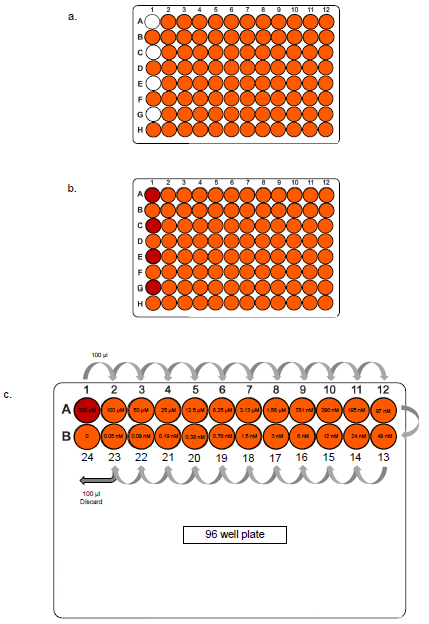Advanced Search
Drug sensitivity assays
Last updated date: Oct 1, 2020 Views: 1002 Forks: 0
- 100 μL of culture media (HMI-9 +10% FBS for Trypanosoma brucei) was added to all wells of an opaque 96-well plate except the first well of rows A, C, E and G (Figure 1a).
- 200 μL of a test compound or control drug (typically at 200 µM, i.e. double the final concentration) was added to each of the empty wells A1, C1, E1 and G1 (Figure 1b).
- Drugs were serially diluted in 100 μL of complete HMI-9 media across two rows of the plate, by transferring 100 µL well-to-well, starting with 100 µL from A1 to A2 and mixing thoroughly by pipetting up-and-down at least 5 times in the receiving well before taking 100 µL to the next well (Figure 1c). From the 23rd well, 100 µL is discarded instead of passed on to the last well (B1 for the first serial dilution), leaving a control well with only culture media.
- 100 μL of cell suspension, at a density of a 2×105 cells/mL, was added to each well (resulting in a final volume of 200 μL per well), to give a final cell density 1×105 cells/mL in each well.
- The plate was then incubated for exactly 48 h at 37 °C in an atmosphere containing 5% CO2. The incubator should have a tray of water to provide humidity, preventing excessive evaporation from the wells at the edge of the plate. [Note: different cell types may require different densities, temperatures and/or incubation times for optimal reproducibility]
- 20 µL of a sterile solution of 5 mM resazurin sodium salt (Sigma-Aldrich, Gillingham, UK) in PBS (pH 7.4) was added to all wells.
- The plate was incubated for a further 24 h under the same conditions as before.
- Fluorescence output was measured based on a FLUOstar Optima plate reader (BMG Labtech) at an excitation/emission wavelength of 544/590 nm. [Note: other fluorimeter plate readers will do equally well, the signal is strong and does not require particularly high sensitivity]
- EC50 values were obtained by fitting to sigmoidal dose response curve of fluorescence against 10Log(test compound concentration, M), using Prism 7.04 software (GraphPad). It is important to choose an equation with a variable slope as different drugs can give very different dose-response curves. Extrapolation from incomplete graphs may be possible on a case-by- case basis if substantially more than half the curve is obtained and the bottom value is fixed at the level of complete cell death obtained by the (known positive control.
- Experiments were performed in at least three independent biological replicates on different days, with different starter cultures.

Figure 1. Preparation of two-fold serial dilutions of drugs. Two rows of a white-96 well plate are shown to demonstrate. (a) 100 μl culture media was added to all wells highlighted in orange. (b) 100 μl of drug in the same media (at 200 µM) was added to the first well of the top row, highlighted in red.
(c) 100 μl of which was then added to the next well. The transfer of 100 μl in each well was continued to half the drug concentration. From the penultimate well, 100 μl was discarded, leaving a control well
(24) with only culture media. The same was done for serial dilution in rows C/D, E/F and G/H.
- Alghamdi, A H and De Koning, H(2020). Drug sensitivity assays. Bio-protocol Preprint. bio-protocol.org/prep531.
- Alghamdi, A. H., Munday, J. C., Campagnaro, G. D., Gurvic, D., Svensson, F., Okpara, C. E., Kumar, A., Quintana, J., Martin Abril, M. E., Milić, P., Watson, L., Paape, D., Settimo, L., Dimitriou, A., Wielinska, J., Smart, G., Anderson, L. F., Woodley, C. M., Kelly, S. P. Y., Ibrahim, H. M., Hulpia, F., Al-Salabi, M. I., Eze, A. A., Sprenger, T., Teka, I. A., Gudin, S., Weyand, S., Field, M., Dardonville, C., Tidwell, R. R., Carrington, M., O'Neill, P., Boykin, D. W., Zachariae, U. and De Koning, H. P.(2020). Positively selected modifications in the pore of TbAQP2 allow pentamidine to enter Trypanosoma brucei. eLife. DOI: 10.7554/eLife.56416
Do you have any questions about this protocol?
Post your question to gather feedback from the community. We will also invite the authors of this article to respond.
Share
Bluesky
X
Copy link
